Deposition Behavior and Microstructure of Cold-Sprayed Ni-Coated Al Particles
Abstract
:1. Introduction
2. Materials and Methods
2.1. Powder and Coating Preparation
2.2. Particle Velocity
2.3. Adhesion Strength and Microhardness
2.4. Microstructure Characterization
3. Results and Discussion
3.1. Microstructure of Ni-Coated Al Splats
3.2. Microstructure of Ni-Coated Al Coatings
3.3. XRD Patterns of Ni-Coated Al Coatings
3.4. Adhesion Strength and Microhardness of Ni-Coated Al Coatings
4. Conclusions
- The size distribution (D50) of the Ni-coated Al powders with an ellipsoidal or nearly spherical morphology was 84.4 μm. The phase compositions of the Ni-coated Al powder were Ni and Al phases.
- By analyzing the deposition behavior of cold-spraying Ni-coated Al particles, Ni-coated Al splat deposited onto the Al substrate exhibited the same morphology as the original feedstock powder. By increasing the accelerating gas temperature, the embedding depth of the splat deposited onto the Al substrate increased, and the plastic deformation of the Al substrate (e.g., gap, revers, and ripple) was more severe.
- Due to the higher microhardness of the Q235 steel substrate, there was no plastic deformation that occurred on the Q235 steel substrate surface. At an accelerating gas temperature of 200 ℃, the Ni-coated Al particle deposited on Q235 steel substrate exhibited an ellipsoidal or nearly spherical morphology with a peeling off and falling off phenomenon. As the accelerating gas temperature increased to 400 ℃, the morphology of the Ni-coated Al splat changed from an ellipsoidal or nearly spherical shape to a flattened shape, and warping phenomenon appeared at the edge of the splat.
- Due to the lower microhardness of the Al substrate, an intermixing phenomenon appeared between the coating and Al substrate. Compared with the accelerating gas temperature of 400 °C, there was an increased intermixing interface observed between the coating and Al substrate at an accelerating gas temperature of 200 °C owing to the lower deposition efficiency. The soft Al substrate was beneficial to form the first layer coating, and the ratio of splats adhered on the Al substrate surface at an accelerating gas temperature of 200 °C and 400 °C was 3.17% and 38.24%, respectively. The porosity of the coatings deposited onto the Al substrate at an accelerating gas temperature of 200 °C and 400 °C was 1.41% and 0.33%, respectively, and the thickness of the coatings was 64.7 μm and 140.6 μm, respectively.
- Due to the higher microhardness of the Q235 steel substrate, there was no impact of Ni-coated Al particles embedded into the substrate. Meanwhile, no intermixing phenomenon appeared between the coating and Q235 steel substrate, and it was difficult to form the first layer coating. Due to more rebounding particles, plastic deformation occurred on the Q235 steel substrate surface. The morphology of the deposited particles was closed to the original particles at an accelerating gas temperature of 200 °C. The plastic deformation of the deposited particles was more severe at an accelerating gas temperature of 400 °C, and the morphology of the impacted particles changed from an ellipsoidal or nearly spherical shape to a flattened shape. The porosity of the coatings deposited onto the Q235 steel substrate at an accelerating gas temperature of 200 °C and 400 °C was 1.63% and 0.68%, respectively, and the thickness of the coatings was 102.4 μm and 110.9 μm, respectively.
- The phase compositions of all of the coatings were Ni and Al phases, which were the same as for the original powders. According to FWHMs results of the Ni and Al diffraction peaks of Ni-coated Al powders and coatings, a certain plastic deformation occurred on the Ni-coated Al particles during cold spraying. The plastic deformation of the Ni-coated Al particles was more serious with an increase in accelerating gas temperature, especially the particles deposited onto the Al substrate.
- The mean adhesion strength of the Ni-coated Al coatings deposited onto the Al and Q235 steel substrates at an accelerating gas temperature of 200 °C and 400 °C was 41.6 ± 3.1 and 34.8 ± 1.6 MPa and 21.3 ± 1.5 and 31.5 ± 1.3 MPa, respectively.
- The microhardness of the Ni-coated Al coatings increased with the increase in the accelerating gas temperature. The mean microhardness of the Ni-coated Al coatings deposited onto the Al and Q235 steel substrates at an accelerating gas temperature of 200 °C and 400 °C was 151.6 ± 8.1 and 228.2 ± 10.5 HV0.3 and 136.7 ± 7.8 and 191.6 ± 9.3 HV0.3, respectively. Due to the higher Ni content in the coatings deposited onto the Al substrate, the microhardness of the coatings deposited onto the Al substrate was higher than that of the coatings deposited onto the Q235 steel substrate.
Author Contributions
Funding
Institutional Review Board Statement
Informed Consent Statement
Data Availability Statement
Conflicts of Interest
References
- Ma, X.W.; Zhang, J.F.; Hao, W.W.; Ren, H.P.; Chen, L.; Liu, Y.Z. Microstructure and properties of NiAl-V alloy prepared by arc melting. Rare Met. Mater. Eng. 2018, 47, 3528–3535. [Google Scholar]
- Zhu, S.Y.; Bi, Q.; Wu, H.R.; Yang, J.; Liu, W. NiAl matrix high-temperature self-lubricating composite. Tribol. Lett. 2011, 41, 535–540. [Google Scholar] [CrossRef]
- Li, L.; Wang, L.P.; Zhao, L.K.; Wang, X.F. Microstructure and adhesion strength of NiAl coating prepared on Q235 substrate by combustion synthesis assisted with Cu-Zn interlayer. Surf. Coat. Technol. 2018, 344, 564–571. [Google Scholar] [CrossRef]
- Mishra, S.B.; Chandra, K.; Prakash, S.; Venkataraman, B. Characterisation and erosion behaviour of a plasma sprayed Ni3Al coating on a Fe-based superalloy. Mater. Lett. 2005, 59, 3694–3698. [Google Scholar] [CrossRef]
- Fan, X.Z.; Huang, W.Z.; Zhou, X.; Zou, B.L. Preparation and characterization of NiAl-TiC-TiB2 intermetallic matrix composite coatings by atmospheric plasma spraying of SHS powders. Ceram. Int. 2020, 46, 10512–10520. [Google Scholar] [CrossRef]
- Wang, X.P.; Feng, X.C.; Lu, C.; Yi, G.W.; Jia, J.H.; Li, H.C. Mechanical and tribological properties of plasma sprayed NiAl composite coatings with addition of nanostructured TiO2/Bi2O3. Surf. Coat. Technol. 2018, 349, 157–165. [Google Scholar] [CrossRef]
- Poliarus, O.; Morgiel, J.; Umanskyi, O.; Pomorska, M.; Bobrowski, P.; Szczerba, M.J.; Kostenko, O. Microstructure and wear of thermal sprayed composite NiAl-based coatings. Arch. Civ. Mech. Eng. 2019, 19, 1095–1103. [Google Scholar] [CrossRef]
- Yuan, J.J.; Wang, Q.Z.; Liu, X.Y.; Lou, S.M.; Li, Q.; Wang, Z.M. Microstructures and high-temperature wear behavior of NiAl/WC-Fex coatings on carbon steel by plasma cladding. J. Alloys Compd. 2020, 842, 155850. [Google Scholar] [CrossRef]
- Mehmood, K.; Rafiq, M.A.; NusairKhan, A.; Ahmed, F.; Mudassar Rauf, M. Characterization and wear behavior of heat-treated Ni3Al coatings deposited by air plasma spraying. J. Mater. Eng. Perform. 2016, 25, 2752–2760. [Google Scholar] [CrossRef]
- Yu, Y.J.; Zhou, J.S.; Ren, S.F.; Wang, L.Q.; Xin, B.B.; Cao, S.L. Tribological properties of laser cladding NiAl intermetallic compound coatings at elevated temperatures. Tribol. Int. 2016, 104, 321–327. [Google Scholar] [CrossRef]
- Liu, K.; Li, Y.J.; Wang, J. In-situ reactive fabrication and effect of phosphorus on microstructure evolution of Ni/Ni–Al intermetallic composite coating by laser cladding. Mater. Des. 2016, 105, 171–178. [Google Scholar] [CrossRef]
- Qian, J.G.; Zhang, J.X.; Li, S.Q.; Wang, C. Study on Laser cladding NiAl/Al2O3 coating on magnesium alloy. Rare Met. Mater. Eng. 2013, 42, 466–469. [Google Scholar] [CrossRef]
- Hearley, J.A.; Little, J.A.; Sturgeon, A.J. The effect of spray parameters on the properties of high velocity oxy-fuel NiAl intermetallic coatings. Surf. Coat. Technol. 2000, 123, 210–218. [Google Scholar] [CrossRef]
- Enayatin, M.H.; Karimzadeh, F.; Jafari, M.; Markazi, A.; Tahvilian, A. Microstructural and wear characteristics of HVOF-sprayed nanocrystalline NiAl coating. Wear 2014, 309, 192–199. [Google Scholar] [CrossRef]
- Bai, M.W.; Reddy, L.; Hussain, T. Experimental and thermodynamic investigations on the chlorine-induced corrosion of HVOF thermal sprayed NiAl coatings and 304 stainless steels at 700 °C. Corros. Sci. 2018, 135, 147–157. [Google Scholar] [CrossRef]
- Bolelli, G.; Cannillo, V.; Lusvarghi, L.; Rosa, R.; Valarezo, A.; Choi, W.B.; Dey, R.; Weyant, C.; Sampath, S. Functionally graded WC-Co/NiAl HVOF coatings for damage tolerance, wear and corrosion protection. Sur. Coat. Technol. 2012, 206, 2585–2601. [Google Scholar] [CrossRef]
- Abu-Warda, N.; López, A.J.; López, M.D.; Utrilla, M.V. High temperature corrosion and wear behavior of HVOF-sprayed coating of Al2O3-NiAl on AISI 304 stainless steel. Surf. Coat. Technol. 2019, 359, 35–46. [Google Scholar] [CrossRef]
- Movahedi, B. Fracture toughness and wear behavior of NiAl-based nanocomposite HVOF coatings. Sur. Coat. Technol. 2013, 235, 212–219. [Google Scholar] [CrossRef]
- Li, W.Y.; Cao, C.C.; Yin, S. Solid-state cold spraying of Ti and its alloys: A literature review. Prog. Mater. Sci. 2020, 110, 100633. [Google Scholar] [CrossRef]
- Poza, P.; Garrido-Maneiro, M.Á. Cold-sprayed: Microstructure, mechanical properties, and wear behavior. Prog. Mater. Sci. 2022, 123, 100839. [Google Scholar] [CrossRef]
- Li, W.Y.; Jiang, R.R.; Huang, C.J.; Zhang, Z.H.; Feng, Y. Effect of cold sprayed Al coating on mechanical property and corrosion behavior of friction stir welded AA2024-T351 joint. Mater. Des. 2015, 65, 757–761. [Google Scholar] [CrossRef]
- Suo, X.K.; Yu, M.; Li, W.Y.; Planche, M.P.; Liao, H.L. Effect of substrate preheating on bonding strength of cold-sprayed Mg coatings. J. Therm. Spray Technol. 2012, 21, 1091–1098. [Google Scholar] [CrossRef]
- Chen, C.Y.; Xie, X.L.; Xie, Y.C.; Yan, X.C.; Huang, C.J.; Deng, S.H.; Ren, Z.M.; Liao, H.L. Metallization of polyether ether ketone (PEEK) by copper coating via cold spray. Surf. Coat. Technol. 2018, 342, 209–219. [Google Scholar] [CrossRef]
- Li, C.J.; Li, W.Y. Deposition characteristics of titanium coating in cold spraying. Surf. Coat. Technol. 2003, 167, 278–283. [Google Scholar] [CrossRef]
- Dikici, B.; Topuz, M. Production of annealed cold-sprayed 316L stainless steel coatings for biomedical applications and their invitro corrosion response. Prot. Met. Phys. Chem. 2018, 54, 333–339. [Google Scholar] [CrossRef]
- Song, B.; Voisey, K.T.; Hussain, T. High temperature chlorine-induced corrosion of Ni50Cr coating: HVOLF, HVOGF, cold spray and laser cladding. Surf. Coat. Technol. 2018, 337, 357–369. [Google Scholar] [CrossRef]
- Singh, R.; Schruefer, S.; Wilson, S.; Gibmeier, J.; Vassen, R. Influence of coating thickness on residual stress and adhesion-strength of cold-sprayed Inconel 718 coatings. Surf. Coat. Technol. 2018, 350, 64–73. [Google Scholar] [CrossRef]
- Chen, X.; Wang, H.T.; Ji, G.C.; Bai, X.B.; Dong, Z.X. Deposition behavior of nanostructured WC-23Co particles in cold spraying process. Mater. Manuf. Processes 2016, 31, 1507–1513. [Google Scholar] [CrossRef]
- Yang, G.J.; Gao, P.H.; Li, C.X.; Li, C.J. Mechanical property and wear performance dependence on processing condition for cold-sprayed WC-(nanoWC-Co). Appl. Surf. Sci. 2015, 332, 80–88. [Google Scholar] [CrossRef]
- Bolelli, G.; Dosta, S.; Lusvarghi, L.; Manfredini, T.; Guilemany, J.M.; Cano, I.G. Building up WC-Co coatings by cold spray: A finite element simulation. Surf. Coat. Technol. 2019, 374, 674–689. [Google Scholar] [CrossRef]
- Yang, G.J.; Liao, K.X.; Li, C.J.; Fan, S.Q.; Li, C.X.; Li, S. Formation of pore structure and its influence on the mass transport property of vacuum cold sprayed TiO2 coatings using strengthened nanostructured powder. J. Therm. Spray Technol. 2012, 21, 505–513. [Google Scholar] [CrossRef]
- Winnicki, M.; Gibas, A.; Baszczuk, A.; Jasiorski, M. Low pressure cold spraying of TiO2 on acrylonitrile butadiene styrene (ABS). Surf. Coat. Technol. 2021, 406, 126717. [Google Scholar] [CrossRef]
- Yao, H.L.; Yi, Z.H.; Yao, C.; Zhang, M.X.; Wang, H.T.; Li, S.B.; Bai, X.B.; Chen, Q.Y.; Ji, G.C. Improved corrosion resistance of AZ91D magnesium alloy coated by novel cold-sprayed Zn-HA/Zn double-layer coatings. Ceram. Int. 2020, 46, 7687–7693. [Google Scholar] [CrossRef]
- Chen, X.; Ji, G.C.; Bai, X.B.; Yao, H.L.; Chen, Q.Y.; Zou, Y.L. Microstructures and properties of cold spray nanostructured HA coatings. J. Therm. Spray Technol. 2018, 27, 1344–1355. [Google Scholar] [CrossRef]
- Vilardell, A.M.; Cinca, N.; Garcia-Giralt, N.; Dosta, S.; Cano, I.G.; Nogués, X.; Guilemany, J.M. In-Vitro comparison of hydroxyapatite coatings obtained by cold spray and conventional thermal spray technologies. Mater. Sci. Eng. C 2020, 107, 110306. [Google Scholar] [CrossRef]
- Yang, G.J.; Zhao, S.N.; Li, C.X.; Li, C.J. Effect of phase transformation mechanism on the microstructure of cold-sprayed Ni/Al-Al2O3composite coatings during post-spray annealing treatment. J. Therm. Spray Technol. 2013, 22, 398–405. [Google Scholar] [CrossRef]
- Zhang, Q.; Li, C.J.; Wang, X.R.; Ren, Z.L.; Li, C.X.; Yang, G.J. Formation of NiAlintermetallic compound by cold spraying of ball-milled Ni/Al alloy powder through postannealingtreatment. J. Therm. Spray Technol. 2008, 17, 715–720. [Google Scholar] [CrossRef]
- Bacciochini, A.; Bourdon-Lafleur, S.; Poupart, C.; Radulescu, M.; Jodoin, B. Ni-Al nanoscaleenergetic materials: Phenomena involved during the manufacturing of bulk samples by cold spray. J. Therm. Spray Technol. 2014, 23, 1142–1148. [Google Scholar] [CrossRef]
- Jan, V.; Čupera, J.; Cizek, J. On the search for producing intermetallics by diffusion reaction of cold spray bulk deposits. Surf. Coat. Technol. 2018, 268, 216–223. [Google Scholar] [CrossRef]
- Grujicic, M.; Zhao, C.L.; Tong, C.; DeRosset, W.S.; Helfritch, D. Analysis of the impact velocity of powder particles in the cold-gas dynamic-spray process. Mater. Sci. Eng. A 2004, 368, 222–230. [Google Scholar] [CrossRef]
- Yin, S.; Suo, X.; Liao, H.; Guo, Z.; Wang, X. Significant influence of carrier gas temperature during the cold spray process. Surf. Eng. 2014, 30, 443–450. [Google Scholar] [CrossRef]
- Yin, S.; Cizek, J.; Cupera, J.; Cupera, J.; Hassani, M.; Luo, X.T.; Jenkins, R.; Xie, Y.C.; Li, W.Y.; Lupoi, R. Formation conditions of vortex-like intermixing interfaces in cold spray. Mater. Des. 2021, 200, 109444. [Google Scholar] [CrossRef]
- Gao, P.H.; Li, C.J.; Yang, G.J.; Li, Y.G.; Li, C.X. Influence of substrate hardness transition on built-up of nanostructured WC-12Co by cold spraying. Appl. Surf. Sci. 2010, 256, 2263–2268. [Google Scholar] [CrossRef]
- Yin, S.; Suo, X.K.; Su, J.Q.; Guo, Z.W.; Liao, H.L.; Wang, X.F. Effects of substrate hardness and spray angle on the deposition behavior of cold-sprayed Ti particles. J. Therm. Spray Technol. 2014, 23, 76–83. [Google Scholar] [CrossRef]
- Lukauskaitė, R.; Černašėjus, O.; Škamat, J.; Zabulionis, D.; Stonys, R.; Kalpokaitė-Dičkuvienė, R.; Antonovič, V. The effect of Al-Mg substrate preparation on the adhesion strength of plasma sprayed Ni-Al coatings. Surf. Coat. Technol. 2017, 316, 93–103. [Google Scholar] [CrossRef]
- Chen, X.; Li, C.D.; Xu, S.J.; Hu, Y.; Ji, G.C.; Wang, H.T. Microstructure and microhardness of Ni/Al-TiB2 composite coatings prepared by cold spraying combined with postannealing treatment. Coatings 2019, 9, 565. [Google Scholar] [CrossRef] [Green Version]
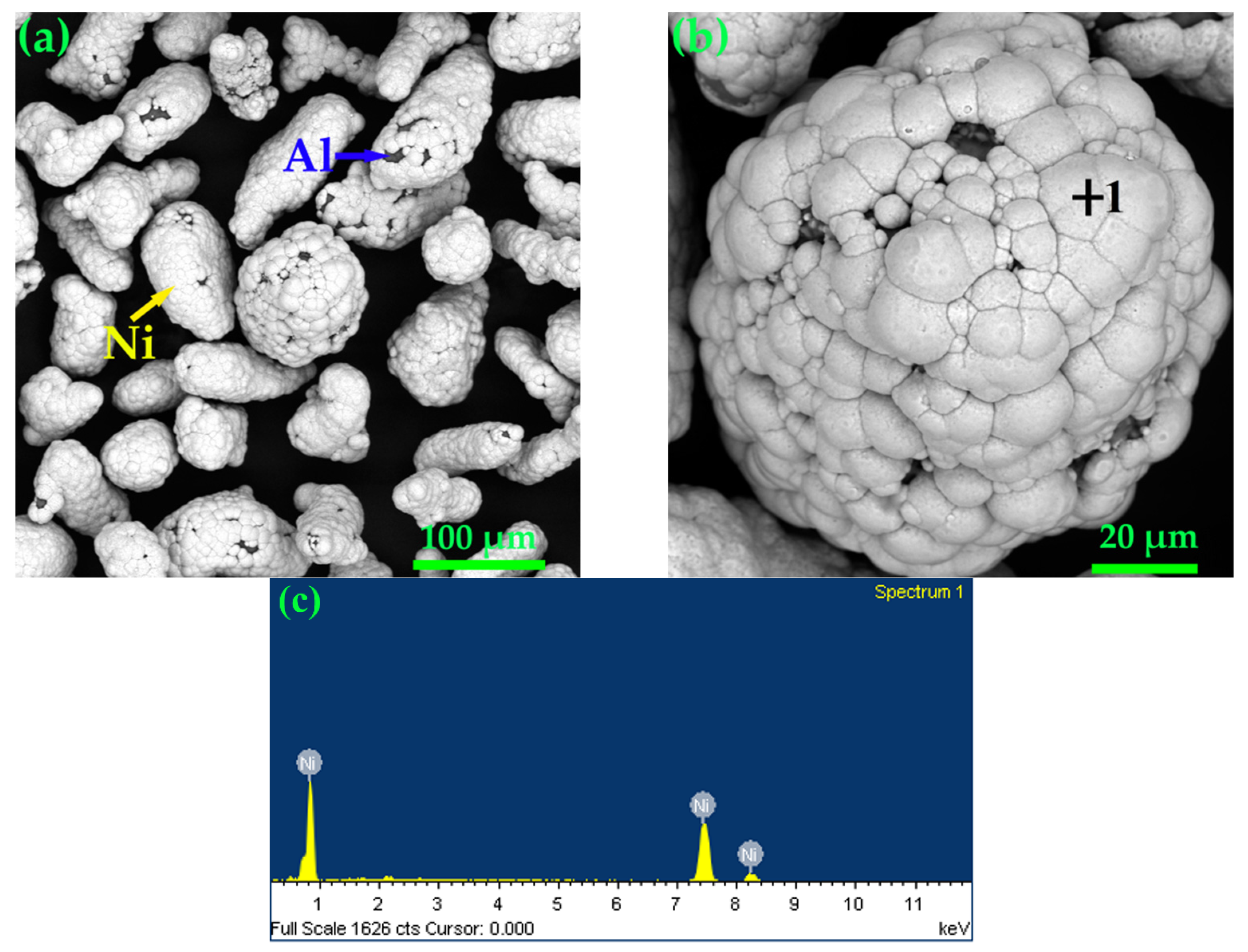

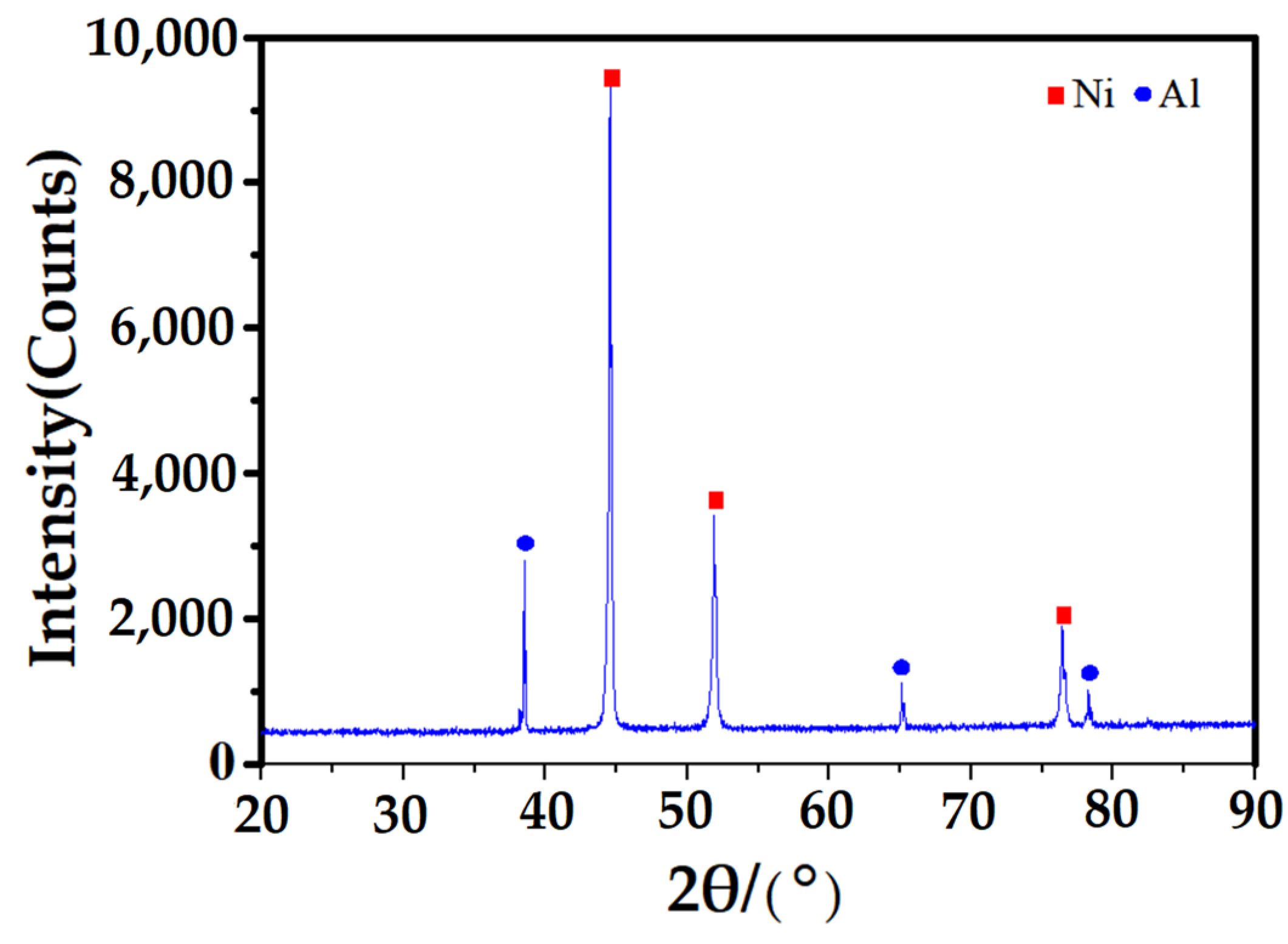
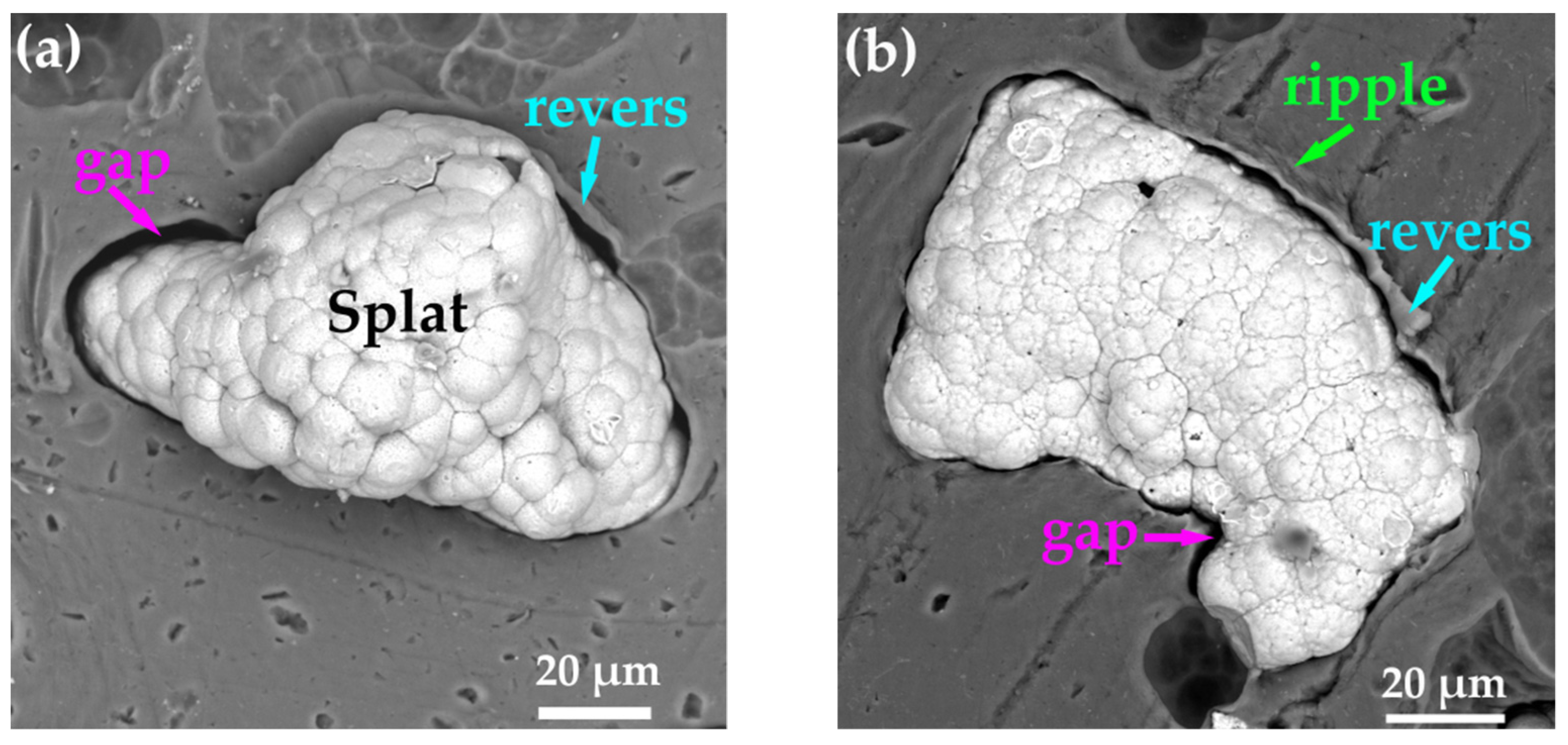
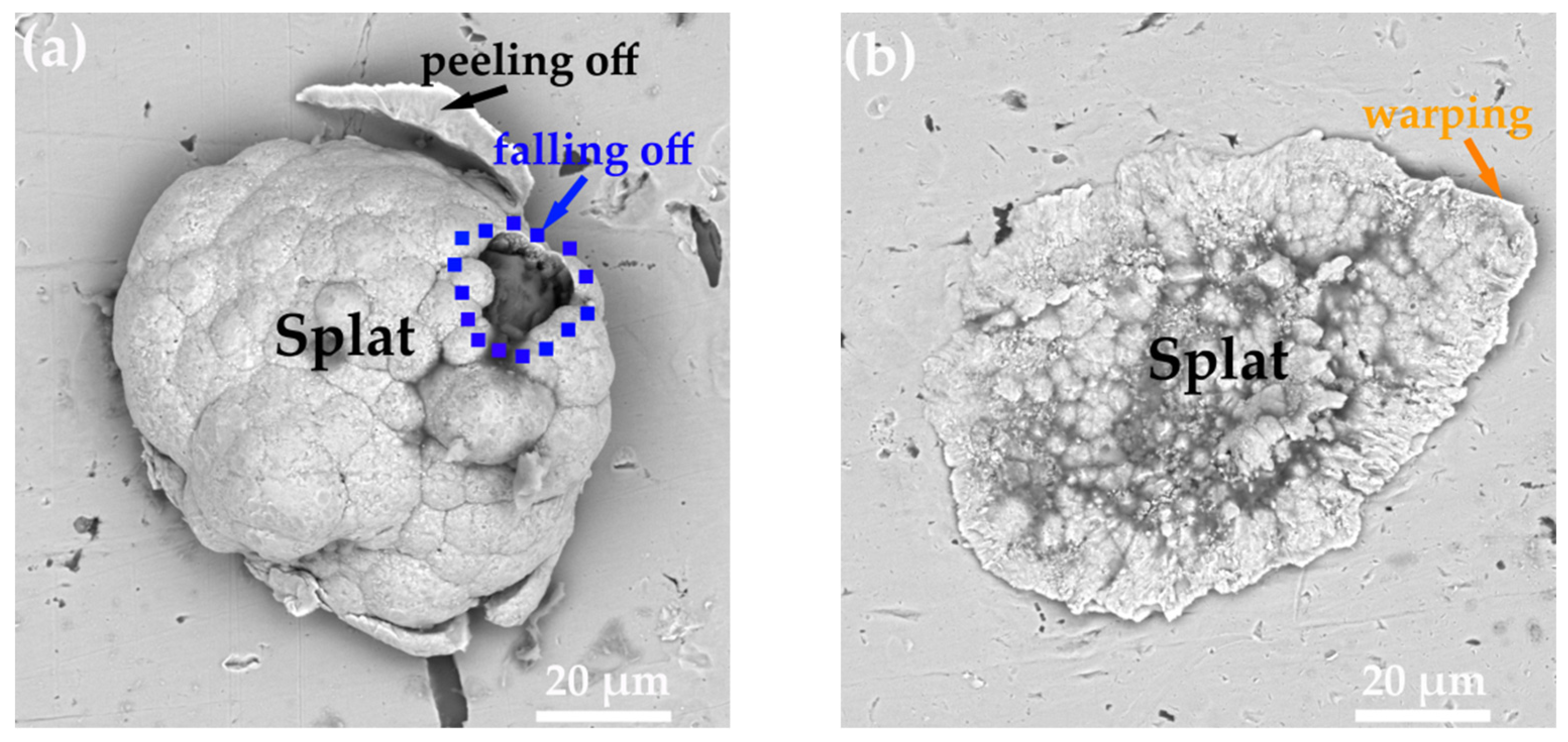
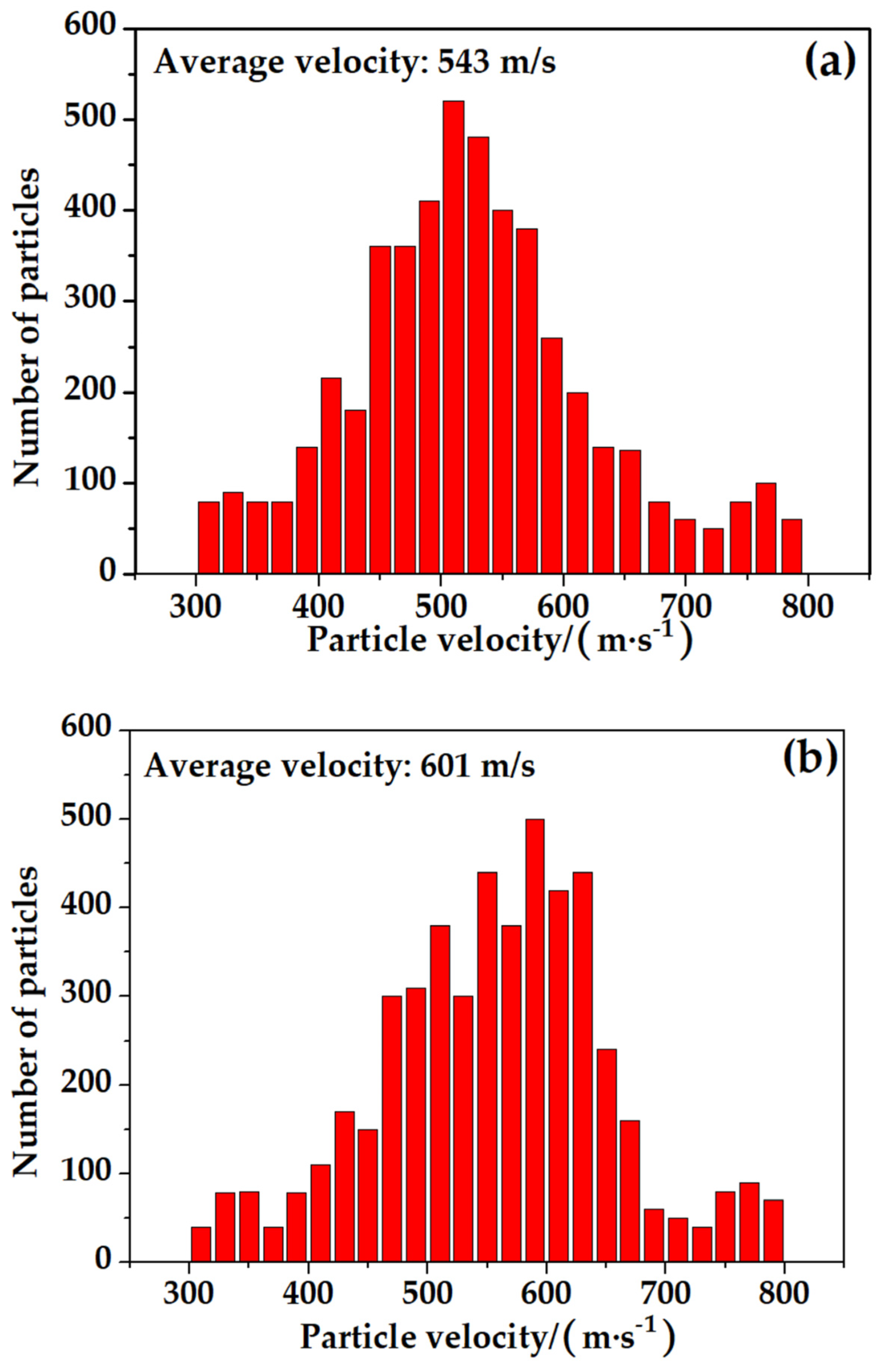
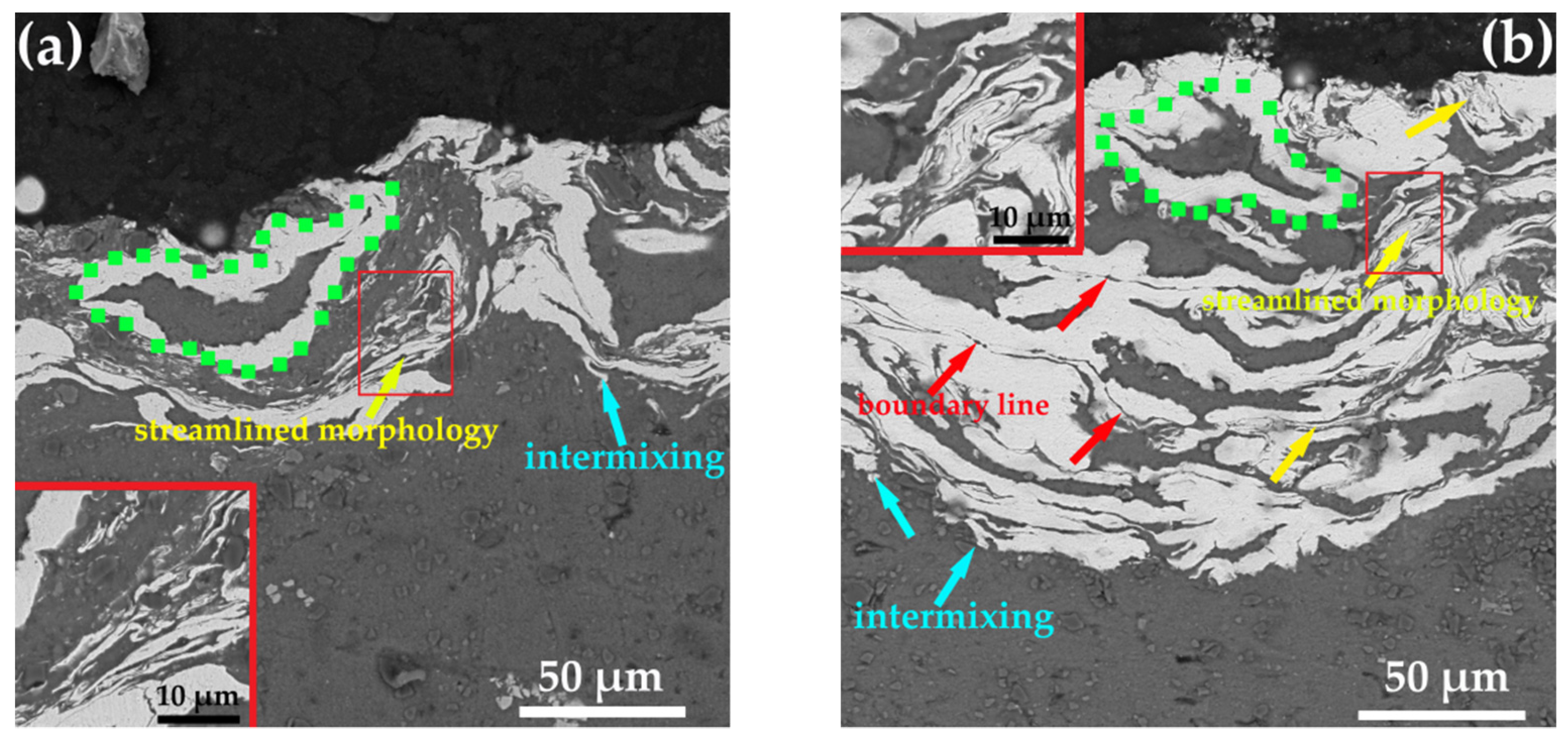

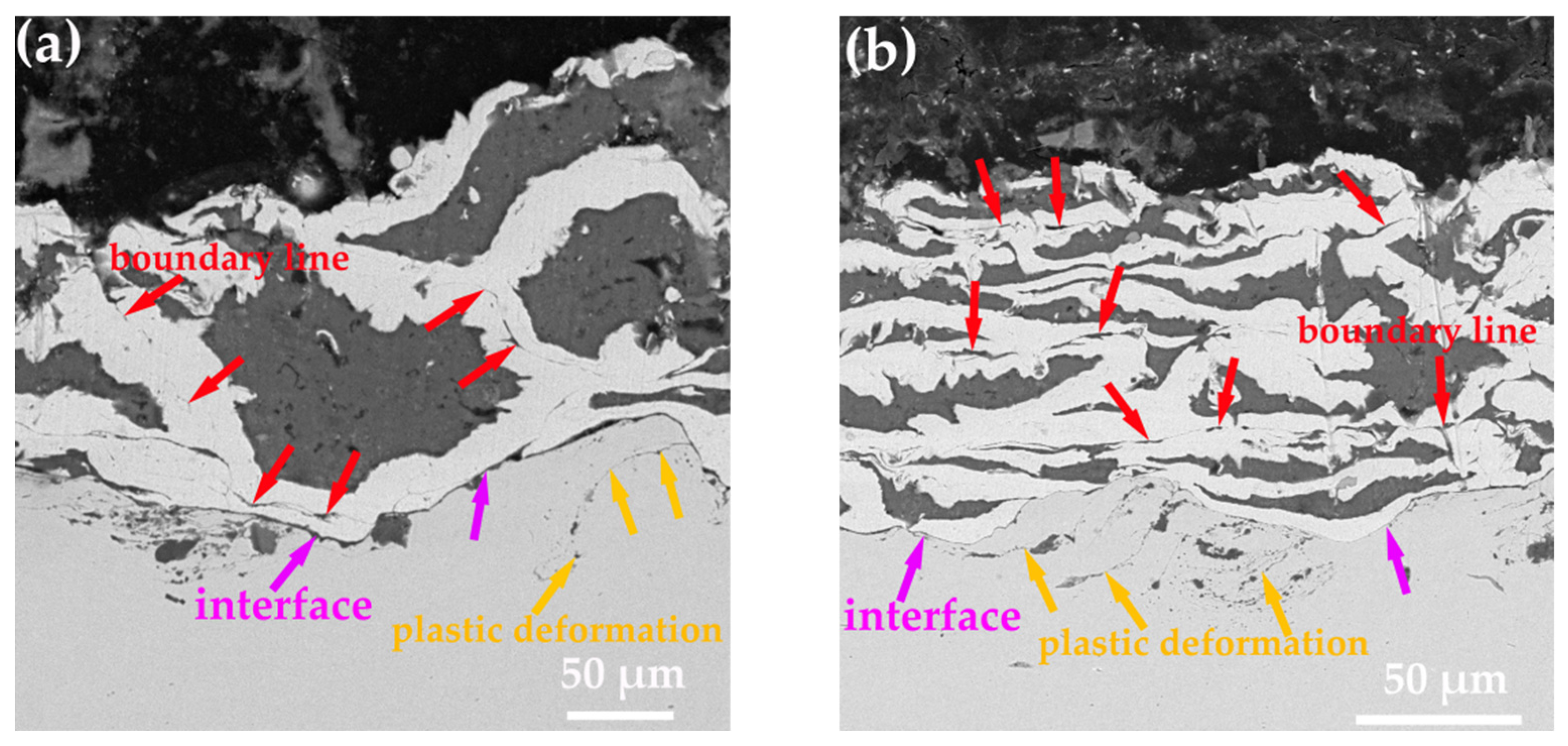



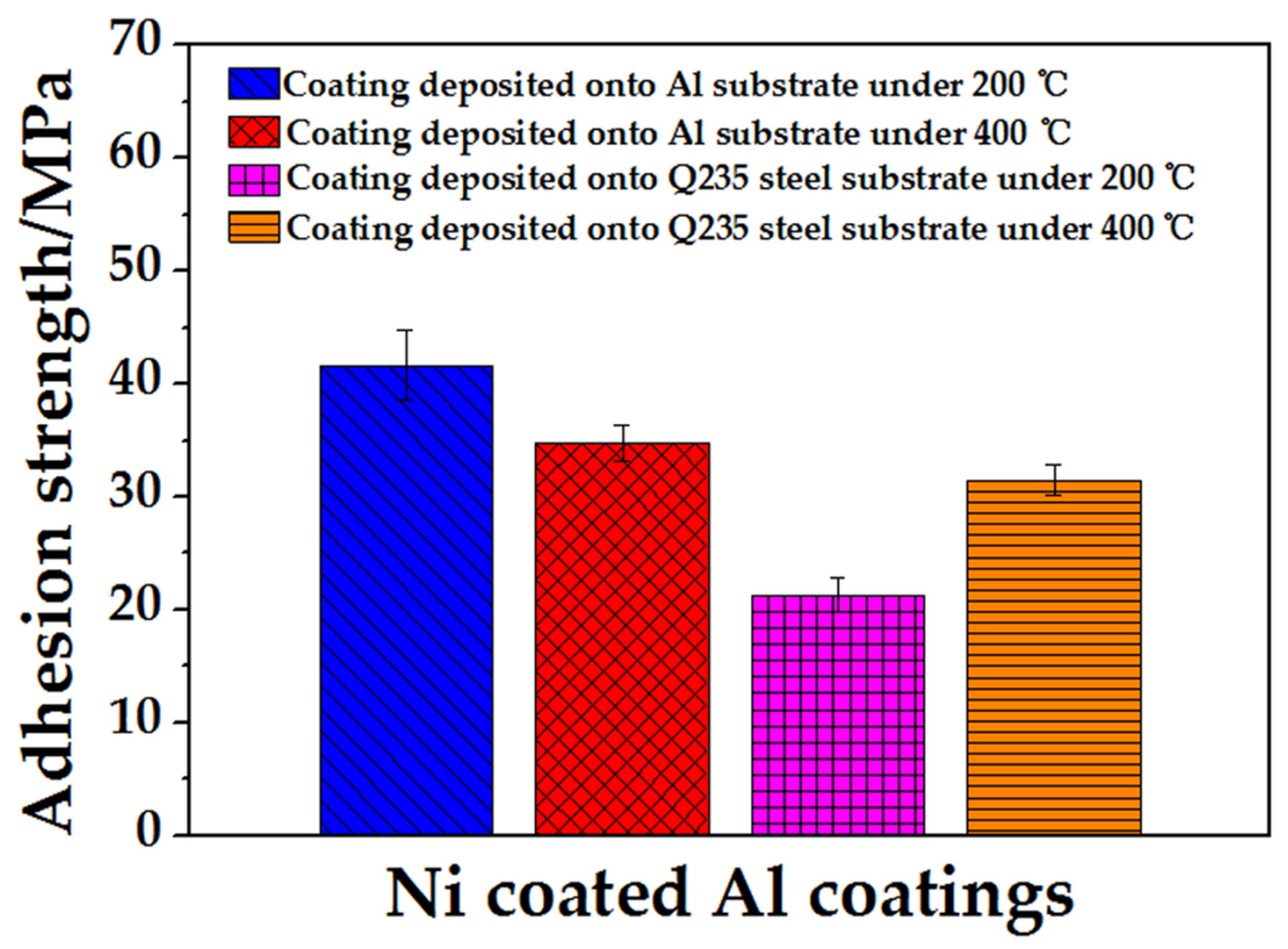
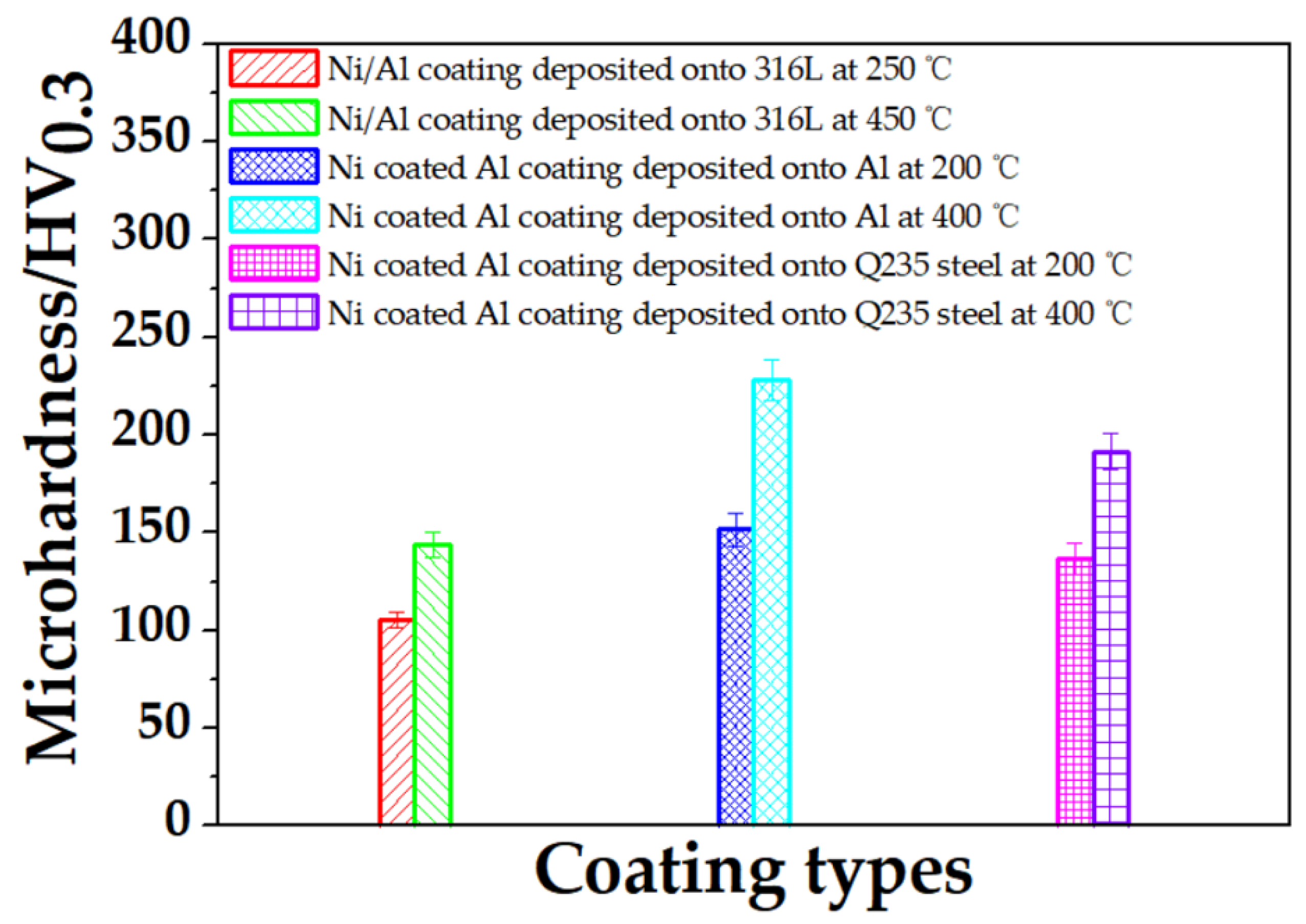
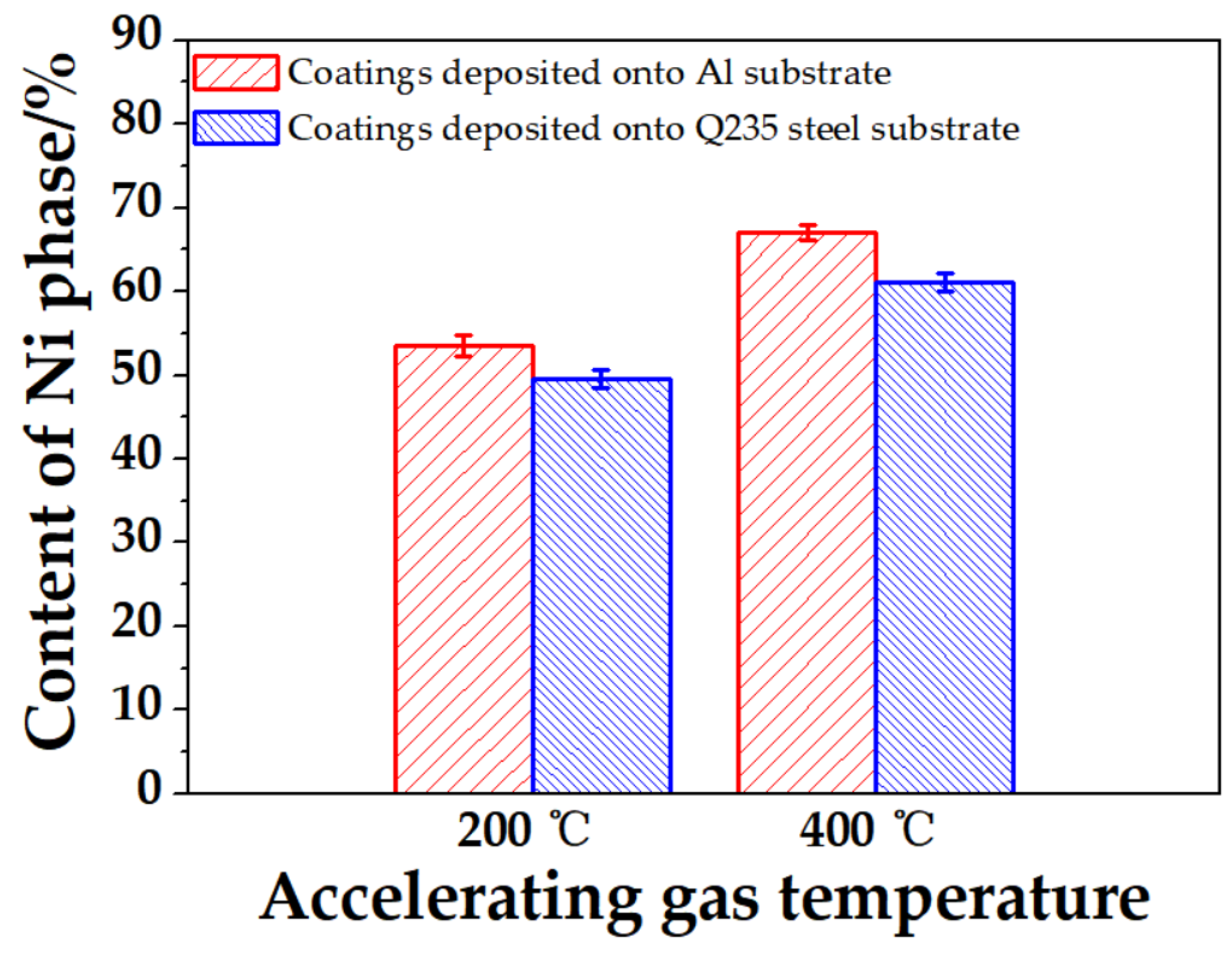
| Parameter | Particle | Coatings |
|---|---|---|
| Accelerating gas pressure/MPa | 2.0 | 2.0 |
| Powder-feeding gas pressure/MPa | 2.2 | 2.2 |
| Gas temperature in gun chamber/°C | 200 ± 10, 400 ± 10 | 200 ± 30, 400 ± 30 |
| Spray distance/mm | 20 | 20 |
| Transverse speed of gun/mm∙s−1 | 400 | 100 |
| Substrate | Q235 steel Al | Q235 steel |
Publisher’s Note: MDPI stays neutral with regard to jurisdictional claims in published maps and institutional affiliations. |
© 2022 by the authors. Licensee MDPI, Basel, Switzerland. This article is an open access article distributed under the terms and conditions of the Creative Commons Attribution (CC BY) license (https://creativecommons.org/licenses/by/4.0/).
Share and Cite
Chen, X.; Zhou, H.; Pi, Z.; Huang, Z. Deposition Behavior and Microstructure of Cold-Sprayed Ni-Coated Al Particles. Coatings 2022, 12, 544. https://doi.org/10.3390/coatings12040544
Chen X, Zhou H, Pi Z, Huang Z. Deposition Behavior and Microstructure of Cold-Sprayed Ni-Coated Al Particles. Coatings. 2022; 12(4):544. https://doi.org/10.3390/coatings12040544
Chicago/Turabian StyleChen, Xiao, Hongkai Zhou, Zhimin Pi, and Zhiwu Huang. 2022. "Deposition Behavior and Microstructure of Cold-Sprayed Ni-Coated Al Particles" Coatings 12, no. 4: 544. https://doi.org/10.3390/coatings12040544






